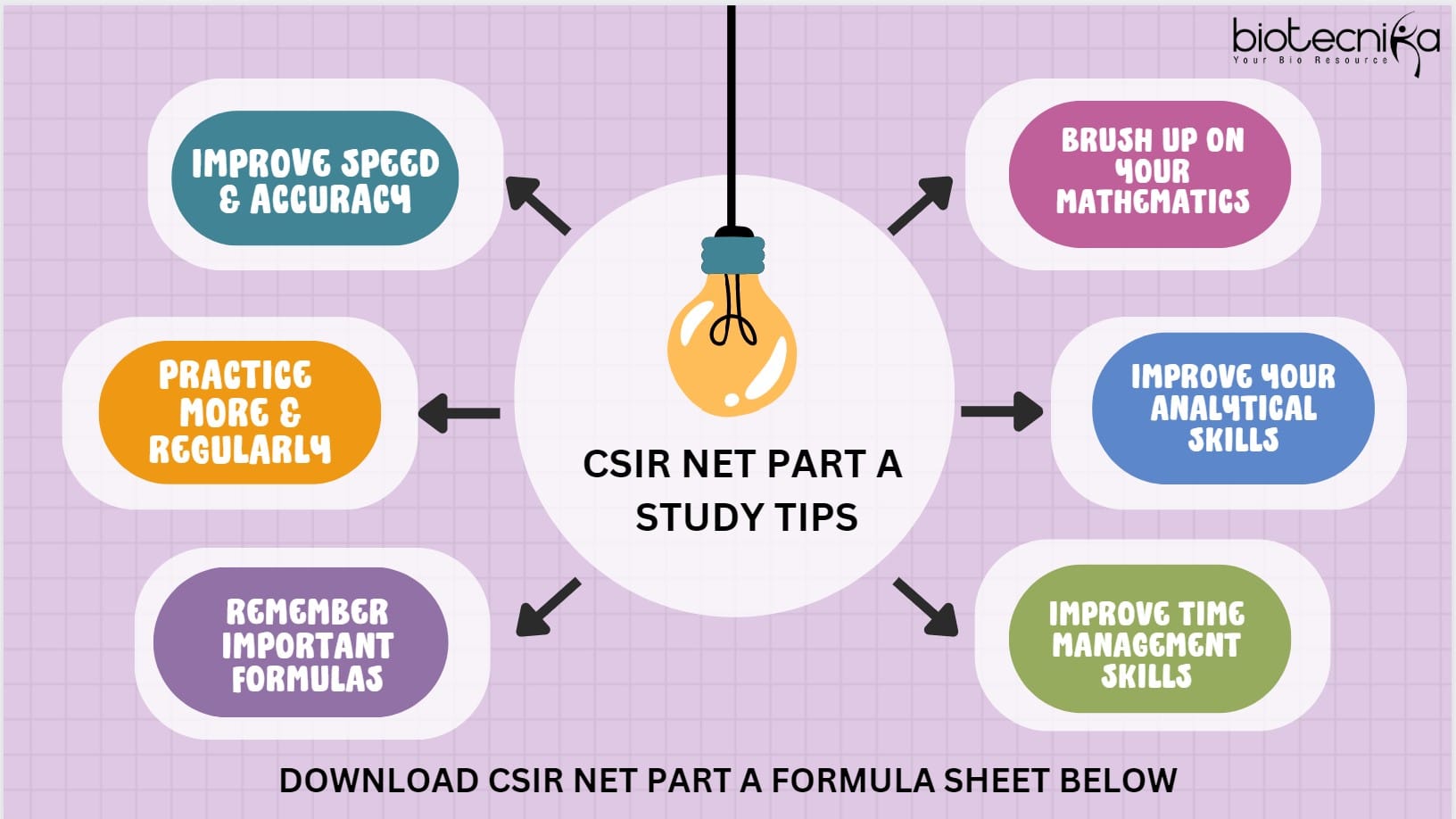CSIR NET PART A Life Science
Preparing for the General Aptitude section – PART A of the CSIR NET exam can be challenging. However, with a strategic study plan, one can easily crack this section and score well in the exam. In this article, we will discuss how to study each topic smartly, provide sample questions, and explain the tricks to solve them faster.
PART A of the CSIR NET Life Science Exam will consist of 20 questions related to General Science, Quantitative Reasoning & Analysis, and Research Aptitude. Candidates must answer 15 out of these 20 questions, with each question carrying 2 marks. The total marks allocated to Part A is 30 out of 200. Instead of skipping this section, practice PART A questions, and go through some important formulas and you can score some extra marks that can get your desired JRF or LS rank easily.
Download CSIR NET PART A Life Science General Aptitude Full Formula Sheet PDF
1. Observation Skills
Observation skills play a vital role in the General Aptitude section. It tests a candidate’s ability to observe and identify details in given situations. To enhance observation skills, one should start observing their surroundings and noting
down small details like colors, shapes, and patterns.Sample Question: Look at the following picture and answer the question below.
Picture: A person is standing on a chair trying to reach something from the top shelf of a closet.
Question: What is the person’s gender, and what is the person trying to reach?
Solution: To quickly identify the gender of the person, look for details such as clothing or hairstyle. To determine what the person is trying to reach, analyze the height of the closet shelf and the person’s position on the chair.
Download CSIR NET PART A General Aptitude Full Formula Sheet PDF
Smart Trick: Look for small details in the picture that can help identify the gender of the person and analyze the position and height to determine what the person is trying to reach.
2. Logical Deductions
Logical deductions require reasoning skills that involve identifying patterns and relationships between different elements. To study this topic, one should focus on solving logical puzzles and games that require critical thinking and analysis.
Sample Question:
If all apples are fruits, and all fruits are healthy, then all apples are healthy.
Solution:
Identify the relationship between the elements given in the question. In this case, the relationship is that apples are a type of fruit, and fruits are healthy. By identifying the relationship, we can quickly deduce that all apples are healthy.
Smart Trick: Identify the relationship between the given elements and use it to deduce the solution quickly.
3. Sequence & Series
Sequence and Series is a mathematical concept that involves identifying patterns in a series of numbers. To study this topic, one should focus on solving numerical problems related to arithmetic, geometric, and harmonic progression.
Sample Question: What is the sum of the first 10 even numbers?
Solution: Identify the pattern in the series of even numbers, which is that every second number is even. Then use the formula for the sum of the first n terms of an arithmetic progression, which is n/2 (2a + (n-1)d). In this case, a=2, d=2, and n=10, so the answer is 110.
Smart Trick: Identify the pattern in the series to find a quick solution, and use the formula for the sum of the first n terms of an arithmetic progression.
4. Numerical Ability
Numerical Ability is a topic that tests the candidate’s ability to solve numerical problems quickly and accurately. To study this topic, one should focus on solving problems related to fractions, percentages, ratios, and decimals.
Sample Question: If a machine can produce 500 units in 4 hours, how many units can it produce in 7 hours?
Solution: Use the concept of proportionality to solve the problem. The machine can produce 500/4 = 125 units in one hour. So, in 7 hours, it can produce 125 x 7 = 875 units.
Smart Trick: Use the concept of proportionality to solve the problem quickly.
Download CSIR NET PART A Life Science General Aptitude Full Formula Sheet PDF
5. Quadratic Equations
Quadratic Equation is a topic that involves solving equations of the form ax²+bx+c=0. To study this topic, one should focus on solving problems related to finding the roots of quadratic equations using the quadratic formula or completing the square method.
Sample Question: Solve the equation 2x² + 5x – 3 = 0.
Solution:
Use the quadratic formula (-b ± sqrt(b² – 4ac))/2a to solve the equation. In this case, a=2, b=5, and c=-3. Substituting the values into the formula, we get:
x = (-5 ± sqrt(49)) / 4
x = (-5 ± 7) / 4
So the two solutions are x = -3/2 and x = 1/2.
Smart Trick: Memorize the quadratic formula to solve the problem quickly, and factor the equation to simplify the problem when possible.
6. Data Analysis
Data Analysis is a topic that involves analyzing data and drawing conclusions from it. To study this topic, one should focus on solving problems related to bar graphs, pie charts, and line graphs.
Sample Question: The following table shows the number of students enrolled in a college over the past five years. Draw a line graph to show the trend in enrollment.
Year Enrollment
2017 500
2018 600
2019 700
2020 800
2021 900
Solution:
Plot the given data points on the graph paper and connect them with straight lines to form a line graph. The x-axis represents the year, and the y-axis represents the enrollment.
7. Average, Profit & Loss
Average, Profit & Loss is a topic that involves calculating averages and finding the profit or loss in a given situation. To study this topic, one should focus on solving problems related to calculating the average of a set of numbers, and finding the percentage of profit or loss in a given scenario.
Sample Question: A shopkeeper buys a shirt for Rs. 600 and sells it for Rs. 750. What is his profit percentage?
Solution: Calculate the profit first, which is Rs. 150. Then calculate the profit percentage using the formula (profit/cost price) x 100%. In this case, the profit percentage is (150/600) x 100% = 25%.
Smart Trick: Use the formula for profit percentage to quickly calculate the solution.
8. Geometry of Shapes
The geometry of Shapes is a topic that involves identifying and analyzing different shapes and their properties. To study this topic, one should focus on solving problems related to the properties of different shapes like circles, triangles, and rectangles.
Sample Question: What is the area of a circle with a radius of 5 cm?
Solution: Use the formula for the area of a circle, which is A = πr². In this case, the radius is 5 cm, so the area is A = π(5)² = 25π cm².
Smart Trick: Memorize the formula for the area of a circle to quickly calculate the solution.
9. Measurement
Measurement is a topic that involves measuring quantities like length, mass, and time. To study this topic, one should focus on solving problems related to conversion of units and estimation.
Sample Question: Convert 2 meters to centimeters.
Solution: Multiply the given value by 100 to convert meters to centimeters. In this case, 2 meters = 2 x 100 = 200 centimeters.
Smart Trick: Memorize the conversion factors for common units to quickly convert between units.
10. Directional Geometry
Directional Geometry is a topic that involves identifying and analyzing the direction and position of objects in space. To study this topic, one should focus on solving problems related to finding the angle between two objects and determining the distance between them.
Sample Question: What is the angle between the hour hand and the minute hand of a clock when the time is 3:15?
Solution: The minute hand is pointing at 3, and the hour hand is pointing between 3 and 4. The angle between the hands can be calculated using the formula |(30h – 11m)/2|, where h is the hour and m is the minute. In this case, h=3 and m=15, so the angle between the hands is |(30 x 3 – 11 x 15)/2| = 97.5 degrees.
Download CSIR NET PART A Life Science General Aptitude Full Formula Sheet PDF
Smart Trick: Memorize the formula for calculating the angle between the hands of a clock to quickly solve the problem.
11. Moving Object Dynamics
Moving Object Dynamics is a topic that involves analyzing the motion of objects and their acceleration. To study this topic, one should focus on solving problems related to the distance, velocity, and acceleration of moving objects.
Sample Question: A car starts from rest and accelerates uniformly at a rate of 4 m/s². What is the distance traveled by the car in 10 seconds?
Solution: Use the formula for distance traveled by a uniformly accelerating object, which is d = 1/2at², where a is the acceleration and t is the time. In this case, a=4 m/s² and t=10 s, so the distance traveled is d = 1/2 x 4 x 10² = 200 m.
Smart Trick: Memorize the formula for distance traveled by a uniformly accelerating object to quickly solve the problem.
12. Probability
Probability is a topic that involves calculating the likelihood of an event occurring. To study this topic, one should focus on solving problems related to finding the probability of an event and using probability to calculate the expected value.
Sample Question: What is the probability of getting a sum of 7 when rolling two dice?
Solution: There are 36 possible outcomes when rolling two dice. To get a sum of 7, the dice must show (1, 6), (2, 5), (3, 4), (4, 3), (5, 2), or (6, 1). So there are 6 possible outcomes that result in a sum of 7. Therefore, the probability of getting a sum of 7 is 6/36 = 1/6.
Smart Trick: Memorize the number of possible outcomes for rolling two dice and the outcomes that result in a sum of 7 to quickly calculate the probability.
13. Permutation & Combination
Permutation & Combination is a topic that involves calculating the number of ways to arrange objects. To study this topic, one should focus on solving problems related to permutation and combination, and identifying when to use each.
Sample Question: In how many ways can 5 books be arranged on a shelf?
Solution: The number of ways to arrange 5 books on a shelf is 5! (read as “5 factorial”), which is equal to 5 x 4 x 3 x 2 x 1 = 120 ways.
Smart Trick: Memorize the formula for calculating the number of ways to arrange objects (n!) and use it to quickly solve the problem.
14. Clock & Calendar
Clock & Calendar is a topic that involves identifying the time and date on a clock or calendar. To study this topic, one should focus on solving problems related to finding the time interval between two events and identifying the day of the week for a given date.
Sample Question: What day of the week is July 4th, 2025?
Solution: Use the formula for calculating the day of the week for a given date. In this case, the formula is (date + [date/4] + year code + century code) mod 7, where the year code and century code can be found using a table. For July 4th, 2025, the year code is 1, the century code is 0, and the date code is 4. Substituting the values into the formula, we get (4 + 1 + 0 + 2) mod 7 = 0, which corresponds to Sunday.
Smart Trick: Memorize the formula for calculating the day of the week for a given date and use it to quickly find the answer.
Download CSIR NET PART Life Science A General Aptitude Full Formula Sheet PDF
15. Problems on Work
Problems on Work is a topic that involves calculating the amount of work done by a person or machine. To study this topic, one should focus on solving problems related to the time taken to complete a task and the efficiency of a person or machine.
Sample Question: A machine can complete a task in 8 hours. If two machines work together, how long will it take to complete the same task?
Solution: Use the formula for calculating the time taken to complete a task when multiple machines work together, which is T = (W/E), where T is the time taken, W is the amount of work, and E is the efficiency of the machines. In this case, the efficiency of one machine is 1/8, so the efficiency of two machines is 1/4. Therefore, the time taken to complete the task is T = (1/1)/(1/4) = 4 hours.
Smart Trick: Memorize the formula for calculating the time taken to complete a task when multiple machines work together to quickly find the answer.
16. Years, Weeks & Days
Years, Weeks & Days is a topic that involves calculating the number of years, weeks, and days between two dates. To study this topic, one should focus on solving problems related to finding the number of days between two dates and converting the number of days to years, weeks, and days.
Sample Question: How many years, weeks, and days are there between January 1, 2020, and December 31, 2021?
Solution: Calculate the number of days between the two dates using a calendar. In this case, there are 365 days in 2020 and 365 days in 2021 (not including leap years). So the total number of days is 730. Convert the number of days to years, weeks, and days using the formula: years = days/365, weeks = (days mod 365)/7, and days = (days mod 365) mod 7. In this case, the answer is 1 year, 0 weeks, and 1 day.
Smart Trick: Memorize the formula for converting the number of days to years, weeks, and days to quickly find the answer.
17. Basic Science
Basic Science is a topic that involves testing a hypothesis through experiments and observations. To study this topic, one should focus on understanding the scientific method, including formulating a hypothesis, designing an experiment, collecting and analyzing data, and drawing conclusions.
Sample Question: A scientist is testing the effect of light on plant growth. She places two plants in a window with sunlight and two plants in a dark room. After a week, she measures the height of each plant. What is the hypothesis being tested in this experiment?
Solution: The hypothesis being tested in this experiment is whether or not light affects plant growth. The scientist is testing this hypothesis by comparing the growth of plants exposed to sunlight with plants kept in the dark.
Download CSIR NET PART A Life Science General Aptitude Full Formula Sheet PDF
Smart Trick: Focus on understanding the scientific method and identifying the hypothesis being tested in an experiment to quickly solve problems related to basic science.
In conclusion, the general aptitude section of the CSIR NET exam covers a wide range of topics related to General Science, Quantitative Reasoning & Analysis, and Research Aptitude. To prepare effectively for this section, it is important to understand the concepts and formulas related to each topic and practice solving problems using smart techniques and shortcuts. By following the tips and tricks outlined in this article and dedicating enough time to studying and practicing, candidates can feel confident and prepared to tackle the general aptitude section of the CSIR NET exam.
CSIR NET PART A Life science, General Aptitude Syllabus, Formula PDF










































